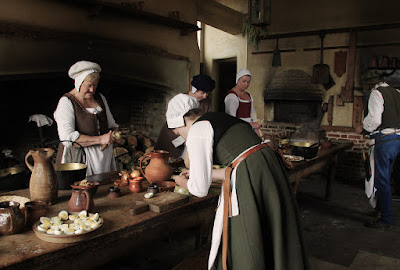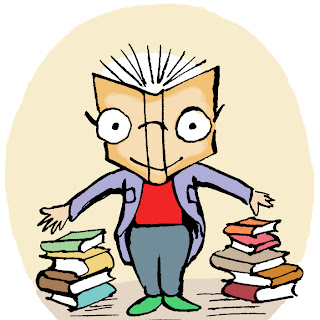INSPIRATION Look who's coming for dinner
You may well know that I run a small literary-themed B&B on the coast of Sussex. August, unsurprisingly, is one of our busiest times. Ironing sheets led me to think about entertaining guests and how they are made to feel welcome – or not.
Being a generous host is a cultural given in my native Yorkshire. It is unacceptable for a guest to leave the table without being stuffed – or 'pogged' as my dialect has it. Northern Ireland seems to be the same – a warm welcome and a grand spread are essential. We found weighing scales in two of the National Trust stately homes we visited there – in days gone by, they'd weigh lords and ladies at the beginning of their stay and then at the end. Woe betide Cook if there were no gain! Hard to imagine now.
 |
Kentwell Hall - Kitchen by Kotomi https://creativecommons.org/licenses/by-nc/2.0/ |
More recently, Queen Mary (the current queen's grandmother) was apparently a liability to entertain. She loved expensive trinkets. If she saw something she fancied, she might say 'I’m caressing it with my eyes' – and expect you to give it to her. People took to hiding their most loved items when she paid a call.
Differences in etiquette can certainly cause problems. People in some cultures leave a little food on their plates when they're done. It is polite to show they ate the food because it was delicious, not because they were starving. Some folk might then think they didn't like it – and some others can take that as a cue to provide more!
 | |||
| Which cutlery should I use? Dinner setting at Charlecote House, National Trust |
Many years ago in Indiana, I was invited along to dinner at the home of the Vice President of my husband's company. I duly dressed up in a crimson Laura Ashley dress with my best Princess Diana pearls and a velvet bow in my hair. When we arrived, the family were there in jeans and check shirts. One of their young sons nudged the other.
'Gee – is she a princess?'I blushed as red as my frock.
And what a household should offer an honoured guest varies. I know a gentleman who travelled a lot in Arabic countries. He will not eat meat cooked with any form of fruit. In those regions, custom led to pretty much the same dish wherever he went. He ate then out of politeness – but never again.
It's not just food and drink. Sleeping arrangements afterwards can be interesting – be it a sleepover or a feast. Whose needs get precedence? The baby's or the grandparents'? Top-and-tailing four in a bed might not happen quite so much now – but blow-up beds and sofas may have to be organised. Not to mention the washing and ironing. ( Oh dear – here I go again.)
 |
| From The Tiger Who Came To Tea written and illustrated by Judith Kerr |
Some ideas for your own work:
- The preparations for hosting someone important can lead to mix-ups, stress and plenty of incident – all good background in its own right or to dialogue.
- What happens if someone unexpected shows up? Or does something impolite? How do different people react?
- SFF and historical settings can be ‘seen’ through such an event – with purpose. This prevents info-dumping, especially if characters don’t know how the customs and have to be told.
- In contemporary work, there’s still plenty of room for misunderstandings, humour and cultural expression.
- The amount of involvement in such an event depends on the age of the child or the attitudes around them. Plenty of scope for conflict there!
- Could a guest be not quite what they seem? Lots of tales and ballads have characters in disguise. Maybe the hosts are ‘entertaining angels unawares’ – or maybe someone quite else.
*******************************************************
K. M. Lockwood writes and edits in The Garret.
Once downstairs, she runs a tiny writer-friendly B&B or wanders off looking for sea-glass on the Sussex coast.
Website:www.kmlockwood.com
Twitter: @lockwoodwriter











No comments:
We love comments and really appreciate the time it takes to leave one.
Interesting and pithy reactions to a post are brilliant but we also LOVE it when people just say they've read and enjoyed.
We've made it easy to comment by losing the 'are you human?' test, which means we get a lot of spam. Fortunately, Blogger recognises these, so most, if not all, anonymous comments are deleted without reading.